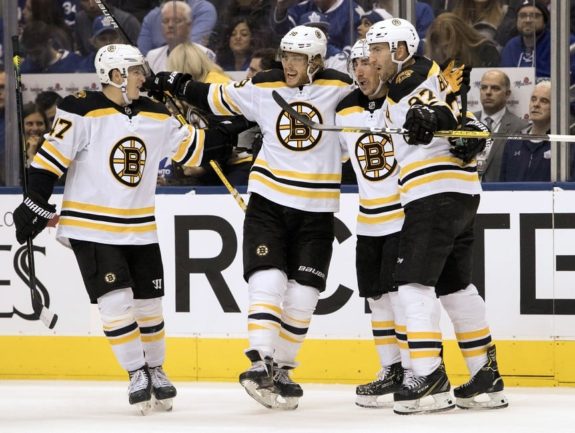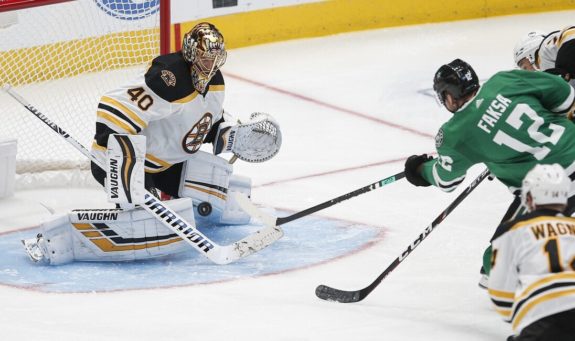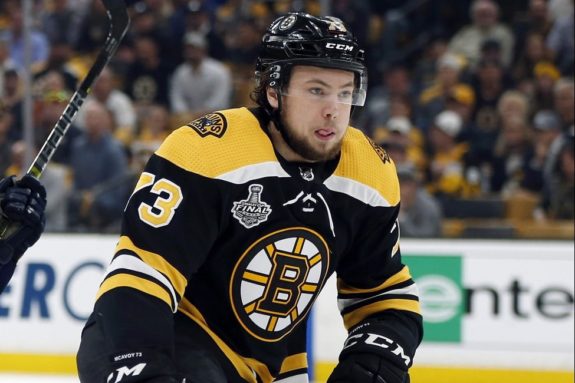The start of the 2019-20 season has been mostly pleasant for the Boston Bruins. After falling just short of a Stanley Cup last spring, the Bruins swiftly swept any concerns of a Cup hangover under the rug, getting out to one of the best starts in the National Hockey League.
And while the team hit some turbulence over the past few weeks, they’re on course to right the ship, and still hold the second-best record in the league, with the fewest number of regulation losses, and the best goal differential out there.

From what we’ve seen, the Bruins are well-poised to make another deep playoff run this season. And while we’ve got a long way to go until the postseason becomes a reality, it seems worthwhile to point out some things to watch for that will make or break the Bruins’ success throughout the rest of the campaign.
Without further ado, here are three areas that will be key to Boston’s success this season.
Goaltending
When it comes to playoff runs, the most important place to look is the crease. It’s an old adage in hockey that is brought up every spring, but one that remains true nonetheless — a hot goaltender can propel a team deep into the postseason. It’s happened plenty of times before, and it will happen again and again.
Last season, the Bruins were blessed with a strong goaltending tandem, and make no mistake, it played a huge role in propelling the team to the Stanley Cup Final. The Bruins didn’t have the best goaltending duo in the league — that honor goes to the New York Islanders, whose pairing of Robin Lehner (.930 save percentage [SV%], 2.13 goals-against average [GAA]) and Thomas Greiss (.927 SV%, 2.28 GAA) marks one of the better team goaltending performances we’ve seen in some years.
But the Bruins were the only other team to have both goaltenders finish top-11 among qualified netminders in GAA. Additionally, Jaroslav Halak earned the trust of his coaching staff, which allowed the Bruins to use him in 40 games over the course of the season. That meant that the Bruins leaned on Tuukka Rask in cage just 46 times — putting him at 25th in the league in games played.
The importance of this is tough to overstate, as it kept Rask fresh throughout the regular season and avoided overworking him before the playoffs — an issue that the Bruins have struggled with in the past. And if his heroic postseason campaign was any indication, the rest throughout the season paid off.

So far this season, the goaltending has held up. Rask currently sits fourth in the league in GAA (2.18) and is tied for fifth in SV% (.928). Meanwhile, Halak’s 2.56 GAA is 13th in the league (and second among backups), while his .924 SV% is 11th in the league (also second among backups).
There’s still a lot — and I emphasize a lot — of hockey to be played before we get into the postseason. But, so far, the Bruins goaltending has picked up right where it left off. That’s very good news for the Bruins.
Depth
A lot of talk surrounding the Bruins so far this season has focused on the first line. It’s very easy to understand why. The Bruins have the leading goalscorer in the league in David Pastrnak, a top-three scorer in Brad Marchand, and a top-16 point-getter in Patrice Bergeron. The only other team sniffing a combination as powerful so far has been the Edmonton Oilers, whose combination of Leon Draisaitl and Connor McDavid has been unreal.
But for all of the attention that the first line gets, the Bruins are far from a one-line team, even if they aren’t operating at full capacity yet (which we’ll get to). As important as that is now, the significance multiplies come playoff time.
David Krejci, for example, has resumed his place of being the underappreciated forward for the Bruins. With the spotlight on his teammates, Krejci is quietly carrying an ever-changing second line once again, with 15 points through 17 games played.
Meanwhile, Charlie Coyle is picking up where he left off as the third-line center, with 11 points through 23 games. Props to Bruins general manager Don Sweeney for that pickup last season. And Danton Heinen, whose value is in his two-way ability, also has 11 points.
Additionally, the Bruins have several defensemen who can make a game-changing impact in the offensive zone. Boston’s fourth-leading point-getter so far, behind only the elite trio, is Torey Krug. The former Michigan State Spartan has been an offensive specialist since he came into the league, and he showed off why with his game-winning individual effort to cap off a stunning comeback win against the Minnesota Wild on Saturday.
That was Krug’s 16th point of the season.
Behind Krug on the blue line, Zdeno Chara has produced at a decent rate (10 points in 23 games), and even Brandon Carlo has notched seven points despite being a lockdown defensive specialist.
Growth
As strong as the Bruins have been so far, and despite running with the best of the pack, the B’s still have room to grow. They’ll need to do just that if they hope to push deep into the postseason once again.
Let’s pick up where we left off, with the defense. Production-wise, the Bruins certainly have room to grow at the blue line. For example, if you predicted heading into this season that Carlo would be hanging with both Charlie McAvoy and Matt Grzelcyk in terms of production, then I’d want to speak with you about some upcoming lottery numbers.
While Carlo’s production has been a bit higher than expected, this is more of a knock on McAvoy and Grzyelcyk than it is praise for Carlo. The good news, of course, is that McAvoy and Grzelyck have room to improve, and they’ll almost certainly grow into it.
This ultimately reflects a bigger picture for the Bruins so far. As good as they’ve been, with the second-best record in all the NHL, the Bruins still aren’t operating at full capacity. If they can shift up a gear to maximum capacity, then the league will be on alert.

McAvoy and Grzelyck have had slower starts to the season than we expected production-wise. That will, in all likelihood, change. Already, we’ve seen an uptick from Grzelcyk, who potted two beautiful goals last Tuesday against New Jersey and followed it up with an assist against Buffalo two days later.
But McAvoy and Grzelcyk aren’t the only ones with more space to fill out. Jake DeBrusk, for example, averaged .61 points per game last season. So far, he’s averaged just .44 this season. Sean Kuraly’s .17 points per game is below his mark of .30 points per game last season.
Meanwhile, the Bruins’ second line has remained something of a question mark, which has been the most evergreen topic regarding the Bruins for years, it seems. If the Bruins can finally plug the hole in the second line, then who’s to say how dangerous they could become?
The point is, the Bruins are among the league’s best teams right now, with plenty of room for improvement. Whether or not they realize that potential over the coming months will be a large factor in determining whether they live up to the bar they set last season — or, perhaps, surpass it.